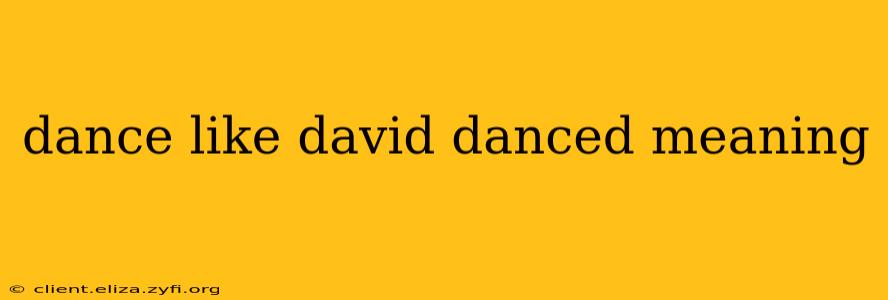The phrase "dance like David danced" isn't a codified expression with a single, universally accepted meaning. Instead, its interpretation depends heavily on context and the audience's understanding of the biblical narrative of David and his interactions with God. The core meaning, however, centers around uninhibited, passionate, and joyful expression before God or, by extension, in any situation demanding exuberant celebration or worship.
Let's delve deeper into the nuances of this evocative phrase and explore some frequently asked questions surrounding its meaning.
What does the Bible say about David's dancing?
The most prominent account of David dancing is found in 2 Samuel 6:14-23. Here, David is bringing the Ark of the Covenant—the symbol of God's presence—to Jerusalem. His joy is so overwhelming that he dances before the Lord with all his might, seemingly oblivious to the onlookers. This act is crucial because it reveals David’s deep reverence and unreserved devotion to God. His dancing wasn't a choreographed performance; it was a spontaneous outburst of worship, a physical manifestation of his inner faith.
Why did David dance before the Lord?
David danced before the Lord because he was overcome with joy and gratitude. The Ark of the Covenant represented God's presence and promise, and its arrival in Jerusalem was a moment of profound significance for David and his people. His exuberant dance wasn't just about celebrating a momentous occasion; it was about expressing the depth of his relationship with God, demonstrating a level of vulnerability and spiritual abandon seldom seen. The act transcends mere physical movement; it becomes a powerful spiritual act.
What does it mean to dance like David danced in a modern context?
In contemporary usage, "dance like David danced" encourages abandoning self-consciousness and fully embracing joy and passion in whatever you do. It's a call to authenticity and uninhibited self-expression. It can be interpreted in various ways:
- Spiritual Context: It encourages uninhibited worship and devotion, expressing one’s faith openly and freely. It pushes individuals to move beyond formality and connect deeply with their spiritual side.
- Secular Context: It encourages letting go of inhibitions and celebrating life fully, expressing one's emotions without reservation, whether through dance, music, or any other creative outlet. It speaks to the importance of passion and enthusiasm in pursuing one’s goals.
- Artistic Context: It emphasizes freedom of expression and artistic integrity. The focus shifts to authentic creation and uninhibited exploration of artistic talent without being constrained by societal norms or expectations.
Is there a difference between David's dance and modern dance?
Yes, there is a significant difference. David’s dance was an unrehearsed, spontaneous expression of profound spiritual emotion within a specific religious context. Modern dance, while it can certainly convey emotion, is often a more structured and stylized art form. Yet, the spirit of David's dance – the uninhibited joy and passionate devotion – remains a powerful aspiration for many modern dancers and artists. The core message transcends the style and form of the dance itself.
What does "dance like no one is watching" mean in comparison?
While "dance like no one is watching" emphasizes the freedom from self-consciousness, "dance like David danced" adds a layer of spiritual depth and intent. "Dance like no one is watching" focuses on personal liberation and uninhibited expression, whereas "dance like David danced" emphasizes the act of worship and devotion, often in a public and potentially judgmental setting. Both phrases encourage uninhibited movement, but the motivation and context differ.
In essence, "dance like David danced" is a powerful metaphor for surrendering to joy, expressing genuine emotion, and embracing vulnerability – a powerful message that resonates across time and contexts. It’s a reminder to live authentically and find freedom in unbridled expression, whether in worship, creativity, or simply celebrating life.
